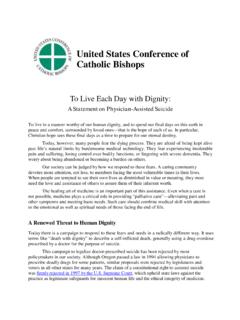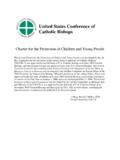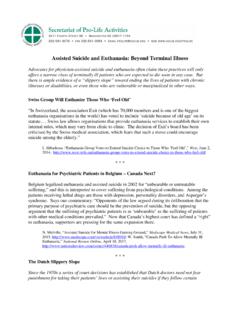Transcription of Catholic Social Teaching Scripture Guide
1 Catholic Social TeachingScripture GuideCatholic Social TeachingScripture GuideIntroductionCatholic Social Teaching has been called the Church s best kept secret. Yet, from the beginning of time, God s call to justice has been clear. The Law and the Prophets both pre-serve a deep tradition of Social justice in ancient Israel. Jesus himself proclaimed and embodied a society ruled by justice and charity the Reign of God. For over one hundred years, the Church has contributed to this tradition in papal and episcopal writings. Finally, we see the Social teachings of the Church written throughout history in the lives of holy men and women. So what is Catholic Social Teaching ? Catholic Social Teaching Catholic Social Teaching (CST) is deeply rooted in the Catholic tradition. Pope John Paul II wrote, The Church s Social Teaching finds its source in Sacred Scripture , beginning with the Book of Genesis and especially in the Gospel and the writings of the Apostles.
2 From the beginning, it was part of the Church s [It was] developed by the Teaching of the Popes on the modern Social question, beginning with the Encyclical Rerum Novarum. 1 Catholic Social TeachingCatholic Social Teaching is Social . Pope Benedict XVI wrote, No man is an island, entire of itself. Our lives are involved with one another, through innumerable interactions they are linked together. No one lives alone. No one sins alone. No one is saved alone. The lives of others continually spill over into mine: in what I think, say, do and achieve. And conversely, my life spills over into that of others: for better and for worse. 2 Catholic Social TeachingCatholic Social Teaching is an expression of the Church s ministry of Teaching . The Bishops call Catholic Social Teaching a constitutive part of the Church s mission to the world. It is not only the prerogative of the institutional church, but of the entire It is the expression of the way that the Church understands society and of her position regarding Social structures and changes.
3 The whole of the Church community priests, religious, and laity participates in the formulation of this Social doctrine. 4 Hope in ActionAs Catholics, we are called to be witnesses to our faith in the way we live our lives. Pope Benedict XVI calls this hope in action. On the one hand, our actions engender hope for us and for others; but at the same time, it is the great hope based upon God s promises that gives us courage and directs our action in good times and bad. 5 As Catholics, our hope is grounded in the resurrection of Christ and the promises of God. Catholic Social Teaching describes how we put that hope into action in our world. Page 2 Catholic Social TeachingScripture GuideSocial Justice and Charitable WorksCatholic Social Teaching isn t only about dropping your spare change into a bucket at Christmas. Jesus calls us to a radically different kind of discipleship a life that is daily marked by care and concern for the poor and for one another.
4 In his gospel, the evangelist Mark tells this story. [Jesus] sat down opposite the treasury and observed how the crowd put money into the treasury. Many rich people put in large sums. A poor widow also came and put in two small coins worth a few cents. Calling his disciples to himself, he said to them, Amen, I say to you, this poor widow put in more than all the other contributors to the treasury. For they have all contributed from their surplus wealth, but she, from her poverty, has contributed all she had, her whole livelihood. 6 Jesus tells us that the widow didn t simply give what was left over after she had bought everything she needed for the week. Instead, she sacrificed her own needs so that she could give to the needs of others. Caring for one another isn t something relegated to the very rich. We are all called to contribute to the needs of our brothers and sisters. Jesus reminds us that generosity and charity are essential to the Christian life.
5 This parable, which follows directly from Jesus comment about Israel s religious leaders, speaks to us on another level, as well: Jesus said, Beware of the scribes, who like to go around in long robes and accept greetings in the marketplaces, seats of honor in synagogues, and places of honor at banquets. They devour the houses of widows and, as a pretext, recite lengthy prayers. They will receive a very severe condemnation. 7 The temple treasury was intended to support the work of the priests and scribes at the temple. Everyone was expected to contribute so that the priests and scribes could afford to eat and live. Jesus comment tells us that the scribes were doing much more than simply living. They wore fancy clothes, attended lavish parties and were getting rich off the offerings of the people. The rich contributed generously to the temple treasury giving out of their surplus. And yet, the scribes demanded that even a poor widow give to the treasury.
6 The widow put in all the money she had to live on, her whole livelihood. Thus, Jesus is not simply commending the widow for her self-sacrificing generosity, but commenting on the unjust systems that would demand a poor widow give her life so that others could live we hear this story on the one hand, we are humbled by the widow s incredible generosity. Her example calls us all to a life of giving and charity. On the other hand, we are angered by a Social system that would demand a poor woman give her life so that others may live as they please. The injustice of the situation cries out to us and calls us to resist systems that perpetuate oppression and poverty. In his recent encyclical, Love in Truth (Caritas in Veritate), Pope Benedict XVI states, If we love others with charity, then first of all we are just towards them. Not only is justice not extraneous to charity, not only is it not an alternative or parallel path to charity; justice is inseparable from charity, and intrinsic to it.
7 Justice is the primary way of charity. 8 Page 3 Catholic Social TeachingScripture GuideThe Two Feet of Love in ActionCharitable works and Social justice have been called the two feet of Catholic Social Teaching . Charitable works meets the immediate needs of persons and families. It treats the symptoms of Social problems. Charitable works calls forth a generous response from individuals and responds to particular situations. Social justice changes Social structures that attack human dignity, oppress people, and contribute to poverty. It focuses on the rights of people, addresses underlying Social causes, and works for long term Social change. Pope Benedict XVI expresses it in this way, The church cannot neglect the service of charity anymore than she can neglect the sacraments and the word. Charity must animate the entire lives of the lay faithful and therefore also their political activity, lived as Social charity.
8 9 Page 4 Using this GuideThis Guide is an adaptation of the Catholic Campaign for Human Development s Scripture Guide . It was created to deepen the understanding of the scriptural foundations of Catholic Social Teaching . The Scripture passages are organized around the seven themes of Catholic Social Teaching . Some passages are short, just a few verses. Others are longer stories or parables that embody the Social teachings. These are only a few suggestions, although it is likely the reader will recall many more examples of these themes in Scripture . Some settings where this resource may be particularly useful include, but are not limited to, small faith -sharing groups, the Rite of Christian Initiation for adults, Journey to Justice retreats, service or immersion reflections, campus ministry activities, and courses that address issues of poverty and injustice. 1 John Paul II. On Human Work, XVI. Spe Salve, Synod of Catholic Bishops.
9 Justice in the World, Council for Justice and Peace. Compendium of the Social doctrine of the church, XVI. Spe Salve, 12:41-447 Mark 12:38-408 Benedict XVI, Caritas in Veritate, 6. Catholic Social TeachingScripture GuideAll people are created in the image of God and thus, all human life, from conception to natural death, is sacred. Through the mystery of Christ, we become children of the Father and temples of the Holy Spirit. God s love for all is the foundation of human dignity. The basic dignity that each person possesses comes from God; therefore all forms of discrimination are always wrong. People take precedence over things and structures. Systems are meant to serve people. And people are meant to serve and care for one another. Scripture tells us repeatedly of God s love for us.
10 We are called to see every person through the eyes of God and to love them because God loved them (and us) 1:26-31 God created man and woman in his 10:17-19 God loves the orphan, the widow, and the stranger. You should 22:2 The Lord is the maker of both rich and 10:25-37 The good Samaritan recognized the dignity in the other and cared for his 4:1-42 Jesus broke with societal and religious customs to honor the dignity of the Samaritan 12: 9-18 Love one another, contribute to the needs of others, live peaceably with Corinthians 3:16 You are holy, for you are God s temple and God dwells in 3:27-28 All Christians are one in Christ 2:1-8 Honor the John 3: 1-2 See what love the Father has for us, that we should be called Children of John 4:7-12 Let us love one another because love is from 5 Life and Dignity of the Human PersonCatholic Social TeachingScripture GuidePage 6 Call to Family, Community, and Participation1 Benedict XVI, Deus Caritas Est, Our faith is rooted in the mystery of the Trinity: the divine relationship between the Father, Son, and Holy Spirit.

















